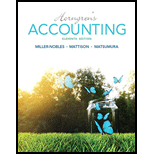
Production Cost report under
The Production cost report is prepared with a view that some of the units started in the process might not have completed at the end of the period. This will result in the difficulty in cost allocation among the units completed and units in process at the end of process.
Therefore, for such purposes the units incomplete shall be converted in to equivalent units of units completed as if whole of the units have been completed. This will help in computing the cost per equivalent unit for each element of cost.
The last step is to compute the cost of units completed and transferred out to the next process and the cost of ending work in process inventory.
Requirement1:
The preparation of Statement of Equivalent production unit for blending department.
Requirement2:
The computation of total cost of units completed and transferred out and cost of ending work in process inventory.
Want to see the full answer?
Check out a sample textbook solution
Chapter 20 Solutions
Horngren's Accounting (11th Edition)
- A company currently has $78 million in sales, $36 million in current assets, $62 million in fixed assets, and $24 million in accounts payable.arrow_forwardPlease provide the solution to this general accounting question with accurate financial calculations.arrow_forwardI need help finding the accurate solution to this financial accounting problem with valid procedures.arrow_forward

 AccountingAccountingISBN:9781337272094Author:WARREN, Carl S., Reeve, James M., Duchac, Jonathan E.Publisher:Cengage Learning,
AccountingAccountingISBN:9781337272094Author:WARREN, Carl S., Reeve, James M., Duchac, Jonathan E.Publisher:Cengage Learning, Accounting Information SystemsAccountingISBN:9781337619202Author:Hall, James A.Publisher:Cengage Learning,
Accounting Information SystemsAccountingISBN:9781337619202Author:Hall, James A.Publisher:Cengage Learning, Horngren's Cost Accounting: A Managerial Emphasis...AccountingISBN:9780134475585Author:Srikant M. Datar, Madhav V. RajanPublisher:PEARSON
Horngren's Cost Accounting: A Managerial Emphasis...AccountingISBN:9780134475585Author:Srikant M. Datar, Madhav V. RajanPublisher:PEARSON Intermediate AccountingAccountingISBN:9781259722660Author:J. David Spiceland, Mark W. Nelson, Wayne M ThomasPublisher:McGraw-Hill Education
Intermediate AccountingAccountingISBN:9781259722660Author:J. David Spiceland, Mark W. Nelson, Wayne M ThomasPublisher:McGraw-Hill Education Financial and Managerial AccountingAccountingISBN:9781259726705Author:John J Wild, Ken W. Shaw, Barbara Chiappetta Fundamental Accounting PrinciplesPublisher:McGraw-Hill Education
Financial and Managerial AccountingAccountingISBN:9781259726705Author:John J Wild, Ken W. Shaw, Barbara Chiappetta Fundamental Accounting PrinciplesPublisher:McGraw-Hill Education





